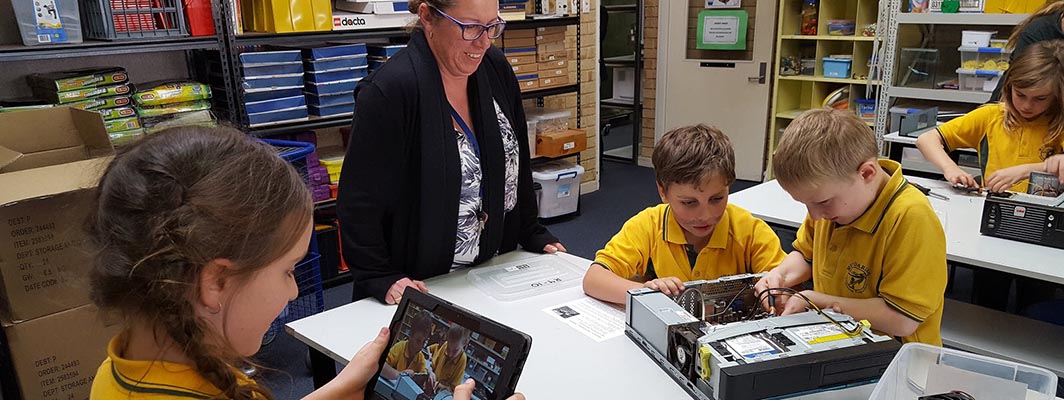
January 22, 2019 | By Stefani Pautz Stephenson, Josh Weisgrau and Elyse Gainor
Powerful learning must be collaborative and connected. Learners reach deeper levels of understanding when they have opportunities to discuss diverse viewpoints, address misconceptions, and solve problems together. By structuring learning experiences that use technology to promote high levels of collaboration and connectivity, teachers can help students build the skills needed for future success.
Research has shown that knowledge is, in large part, socially constructed, particularly in building reasoning and problem-solving skills. Students are highly attuned to social dynamics, and research shows that relationships can drive learning. Harnessing this social drive in the learning environment, whether that be face-to-face or virtual, can take students further than they can go alone.
Working collaboratively towards a common goal, rather than dividing a project into parts that can be done individually, encourages students to learn through discussion, think about new ideas, and consider the viewpoints of others. The benefits of collaborative problem solving go beyond individuals contributing their personal ideas to a common goal. Collaborative problem-solving generates new solutions that individuals would not reach alone, allowing for greater innovation and meaningful iteration. Collaborative inquiry, where learners work together to ask questions, seek answers, and make connections, amplifies student engagement and deeper learning.
Powerful learning gives students a voice in the classroom by empowering them as experts in their own rights. Peer teaching strategies give students the opportunity to learn from one another and contribute to a culture of collaboration. Research has shown that learning from fellow students can foster deep understanding of material and a positive attitude toward the subject matter at hand. Additionally, studies have found that peer teaching is mutually beneficial; simply preparing to teach others can deepen a learner’s own knowledge.
Educators have an important role in ensuring students cultivate a culture of inclusion and equity in group collaboration. By establishing group norms, educators help students reduce the risk of stereotype threat, microaggressions, and other harms of dominant culture in group work. Educators can also promote equity within their classrooms by avoiding ability grouping, or grouping students by their perceived talents.
In addition, the teacher can take the role of “co-learner” with students. This shifts the classroom dynamic to one of a community of learners, with give and take between both teacher and students. For teachers, being a co-learner can also be freeing. As teacher Andrea Kornowski shared regarding her sixth grade STEM day, “While I provided resources to help guide learners with their projects, the greatest resource was the collective intelligence within the room. … You don’t have to be the expert. You just have to be comfortable with learning alongside your learners and asking them for help.”
A key principle of Seymour Papert’s theory of constructionism and a foundation of maker learning is the idea that the creation of artifacts is critical in the learning process. Most important to this idea is that learning happens through the act of creating, rather than only using the created artifact to display knowledge after the fact. Knowing these artifacts will be shared and designing learning projects with an audience in mind helps to build authenticity and engagement in the students’ experiences.
Teachers, too, can make sharing artifacts of teaching and learning the norm in their classrooms. Not only do students benefit when they see what they’ve created matters, but the resources teachers create and share publicly support their own professional learning as well. A commitment to using, creating, and sharing open educational resources (OER) allows teachers to contribute their expertise to support the entire field and receive feedback on their work that can help their own professional growth.
The connectivity of today’s world gives students boundless opportunities to share the artifacts of their learning and connect with each other within the classroom and across the globe. In Digital Promise Global’s Learning Studios program, students in Australia connected with students in California to virtually play board games they each had designed. Students engaged in the MY World 360º Global Challenge had their work screened at the United Nations General Assembly. Try playing a quick round of Mystery Skype with your classroom as a first experience with a virtual exchange.
Connected learning can happen on a local scale by fostering connections with businesses, places of worship, government agencies, and museums where students can reach an authentic audience. Your community is a great source of inspiration to find challenges that engage your students and provide an authentic audience for their work. Teachers can use design thinking as a framework to scaffold collaborative problem solving within the community. Taking on new perspectives is embedded into the design process as learners research user insights, building student empathy skills as well.
Ready for more? Use these resources to support your design of connected and collaborative learning experiences:
If you’re an educator creating powerful learning experiences for your students that are collaborative and connected, consider earning some of these educator micro-credentials to be recognized for and share your accomplishments:
Follow us for the latest updates on this series on Powerful Learning and use our resources to implement powerful learning in your teaching and learning practice.
Blog updated in September 2020.
Citations
By Lauren McMahon and Heather Dowd